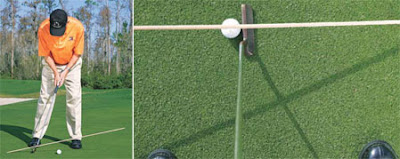
Putter head travels the same distance back and through

Grip the putter in your palms

On short putts, the putter travel straight back and through.


Use the logo on the ball to line up


The putter head is an upward stroke


Toss the ball to the hole to feel how much effort you need to putt

Practice putting to different distances

On the long putts, imagine a big circle around the hole and lag your ball there.
Your goal is to 2 putt or less each hole. Obviously from the shorter range you'll have a better chance of making the putts. From the longer range, you want to just get your ball close to the hole . If you get lucky, the ball may fall in the hole, otherwise walk away with 2 putts and move on. If you try too hard to make the long putts, you'll tend to leave yourself too far from the hole because you've probably put too much pressure on yourself in the first place.
PUTTING GRIP
The putting grip is different from the grip you would use to make the full swing. To putt well, it is essential to place your hands in the right place on the grip, right ball position, steady head, body and good rythmn and feel. There are many different putting putters and styles. The following is a basic putting style.
- Place the putter grip in your palm along your life lines with the left hand on top and the right hand below.
- Place your thumbs on the top side or flat part of the grip(usually the putter grip is flat on top), then wrap your fingers around the grip.
- Lift your left index finger and slide the right hand closer to the left, place your left index finger on top of the trailing fingers of the right hand
- Make sure you grip the putter lightly so you can stroke the putter instead of too much hit or stab.
PUTTING POSTURE
Putting is very personal and you see golfers with many different posture. I would suggest beginners to start with a basic neutral posture and find your preference as you golf more.
- Stand about shoulder width
- Position your weight on the balls of your feet evenly on both feet
- Bend your knees slightly
- Tilt forward from your hips until you eyes are directly above the ball.
- Your arms can be straight or bend depending the length of the putter
- Shaft leans slightly to the left
- Make sure you are aligned square to your target(check on Alignment archive)
- Key is letting your arms hang from your shoulders and being able to look down on the ball to the hole in a straight line
BALL POSITION
Ideal ball position for putting helps roll the ball better on the green. The putter strikes the ball just as past the bottom of the arc creating topspin on the ball. The following exercise will help you find the ideal ball position.
- From your putting set-up, drop a ball under your left eye
- The spot where the ball lands is the ideal position
- Line up the logo on the ball to the hole.
- Place the putter head directly behind the ball, in the middle of the clubface. Match up the line on the putter and the logo of the ball.
- Make sure you have enough tilt over your hips so your arms are not too close to your body and you eyes are directly over the golf ball.
PUTTING STROKE
The putting motion is a very gentle swing like a stroke, not a stab at the ball. The triangle formed between your shoulders and arms work like a pendulum. The key is keeping a very still head and lower body. The stroke is a gentle rocking motion of the upper body maintaining the same flex in your elbows and wrists. Focus more on the arms and shoulders moving not hands. The putter head travels back and forth the same distance. The putter head accelerates through the ball. Always keep your head down for putting.
- For short putts, within 10 feet from the hole, gently rock your shoulders back and through on a straight line. Make sure the putter head travels back and forth equally
- For longer putts, the putter moves on an arc according to your spine angle. The putter head will start from square position to slightly in on the backswing, back to square at impact and slightly on the finish.
PUTTING DISTANCE CONTROL
Speed determines the line. The firmer you putt the less the ball will break, as long as you don't leave yourself too far from the hole, you always want to accelerate through the ball.
All good putters have good feel. That’s the key to control the distance and speed of the ball roll. Here’s 2 drill to help you feel that.
1. Roll the ball with the right hand:
- Set-up over the ball with a ball in your right hand
- Keep your eyes at the hole and feel how much backswing or effort you need to get the ball to the hole by swing your right hand back and through
- Roll or toss the ball towards the hole
The effort you need to roll or toss the ball towards the hole will be about how hard you need to stroke with the putter.
2. Feel the distance
- Take 3 balls for this drill
- Putt the 1st ball by keeping your eyes at the hole
- Putt the 2nd ball by closing your eyes, feeling the distance
- Putt the 3rd ball with a normal stroke looking at the ball
Repeat this drill several times; it will help you develop better feel and control over the speed of the ball.




























































